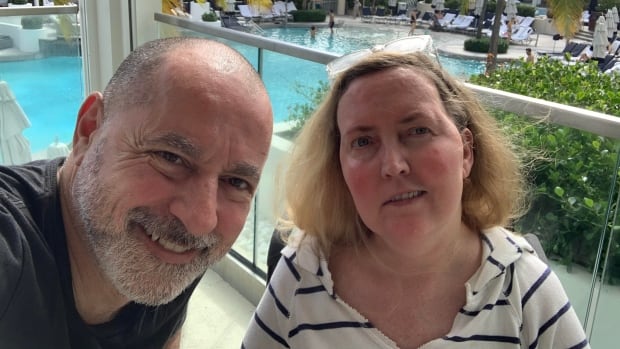With criminal networks shifting to domestic production of fentanyl and other opioids, the focus of law enforcement at Canada’s borders has now shifted to the chemicals used to make the deadly drugs.
The Public Health Agency of Canada estimates that more than 47,000 Canadians have died of toxic drug overdoses since 2016. Four out of every five of accidental overdose deaths recorded this year in Canada involved fentanyl.
The shift away from importing opioids to manufacturing them on Canadian soil began roughly in 2019, when the Chinese government listed fentanyl as a controlled substance and imposed more regulations on its production and export.
Since then, organized crime groups have focused on importing and smuggling the chemicals that go into making fentanyl and other opioids — known as precursors — into Canada.
“Precursors might be [the] primary threat coming into Canada for things that contribute to the deaths of Canadians,” said Dan Anson, the director general of the Canada Border Services Agency’s intelligence and investigations directorate.
But detecting precursors at the border can be difficult, especially if they’re unregulated, Anson said.
“It is challenging to find those because you need a level of front-end detection technology capability to identify what the chemical is,” he said.
Last week, the government released details of a $1.3 billion plan to secure the Canada-U.S. border and allay U.S. president-elect Donald Trump’s concerns about migrants and drugs.
The federal government releases its plan to spend $1.3 billion to secure the border a day after the resignation of a key cabinet minister on cross-border issues. Immigration Minister Marc Miller says Chrystia Freeland’s resignation is a “significant loss” but there’s “a lot of talent on the bench.”
A significant amount of that money is aimed at regulating precursors and intercepting them at the border. The government is promising to use artificial intelligence and imaging tools to help law enforcement and border officials detect precursors.
Ottawa also says it will cut the processing time for banning precursors from 36 months to six months and is promising a new “Chemical Precursor Risk Management Unit” within Health Canada that will help law enforcement agencies intercept the chemicals.
One of the challenges the CBSA faces, Anson said, is the fact that some precursors are legal and have “dual use.”
“Very rarely will you have a chemical that doesn’t have two uses, dual use application. So a lot of these chemicals are used for cleaning and fabrication in other domains,” he said.
But Jennifer Pelley — a director with Health Canada’s controlled substances and overdose directorate — said all the chemicals that are essential to making fentanyl are illegal in Canada.
“There are some additional chemicals that can be used in the illegal production of fentanyl, but it is actually not possible to make fentanyl unless you have one of the essential building blocks that we have controlled,” she told CBC News.
Pelley said the government is careful not to over-regulate precursors or “commodity chemicals” that have multiple uses.
“For these chemicals that have broad legitimate uses, the impacts of scheduling under the [Controlled Drugs and Substances Act] would be severe. It would basically shut down a lot of legitimate commerce,” she said.
“So what we’ve done is focused our efforts on the essential building blocks.”
Organized crime groups have attempted to get around regulations through what Anson calls “chemical masking” — essentially breaking a precursor down to pre-precursors to avoid detection.
“It’s not frequent that we see chemical masking, but it’s a technique that we are familiar with,” he said.
The problem with pre-precursors
Pelley said Health Canada tries to stay ahead of chemical masking by predicting all the ways a precursor can be broken down. She explained the process using a Lego minifigure as a metaphor.
“So we’ve scheduled the Lego minifigure and made it illegal to import the Lego minifigure. So the first thing that organized crime does is they stick a hat on the Lego minifigure and they say, ‘Well, that’s not controlled, right?’ And that’s what we would call a pre-precursor,” she said.
“What we do when we schedule the Lego minifigure is we say the Lego minifigure is controlled regardless of whether it’s wearing a hat, some different hair, maybe a cape. So we control basically everything related to the Lego minifigure.”
Pelley said new chemicals do sometimes pop up but they’re usually detected at the border, then sent to Health Canada to be tested and, if necessary, to go through the regulatory process.
Almost ‘100 per cent’ of precursors come from China
The U.S. has accused the Chinese government of turning a blind eye to companies that sell chemicals others might use to make fentanyl elsewhere in the world. The U.S. government has sanctioned Chinese companies and individuals Washington accuses of profiting from the trade without facing consequences at home.
Anson said “close to 100 per cent” of the precursors seized at the Canadian border come from China.
“We watch for changes to that pattern because there are other fabrication facilities, raw chemical production areas and industrialized areas in south Asia,” he said.
“But for Canada, we tend to see the vast majority of precursor chemicals coming from China.”
Criminals use a variety of hiding places to smuggle the chemicals into Canada, Anson said.
“Our seizures will be in everything from a marine container to an air cargo container and then into letter mail as well. So it’s very important for us to have our guard up for all that,” he said.

As Ottawa prepares to use artificial intelligence as a tool to detect precursors coming into Canada, Anson suggested that organized crime groups could use it to subvert regulations.
“When you’re doing chemical composition and structuring, now there are a lot more resources out there. So you might not need to recruit the bioengineering or the sciences and chemistry grad. It might be somebody with a sophisticated understanding of how to do chemical chains through AI,” he said.
Anson said staying on top of criminal networks and their techniques is a constant game of adaptation.
“We learn from a seizure and then apply that to 100 more seizures, and from those 100 seizures create other targeting rules that will capture patterns that tell us that something might not be right,” he said.








